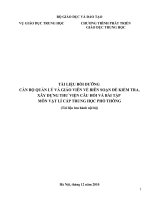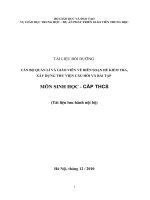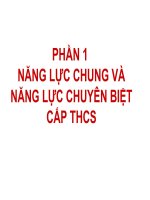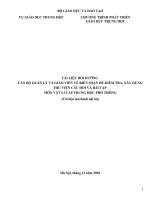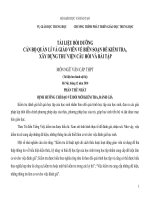Tài liệu Tập huấn ra đề kiểm tra Tiếng Anh THCS 1
Bạn đang xem bản rút gọn của tài liệu. Xem và tải ngay bản đầy đủ của tài liệu tại đây (898.51 KB, 49 trang )
SỞ GIÁO DỤC VÀ ĐÀO TẠO NINH THUẬN
TÀI LIỆU BỒI DƯỠNG GIÁO VIÊN
VỀ BIÊN SOẠN ĐỀ KIỂM TRA,
XÂY DỰNG THƯ VIỆN CÂU HỎI VÀ BÀI TẬP
MÔN TIẾNG ANH
CẤP TRUNG HỌC CƠ SỞ
Báo cáo viên: NGUYỄN TẤN PHƯỚC
Background
in
Tests and
Test
Preparation
Types of tests
Proficiency tests
Achievement tests
Diagnostic tests
Placement tests
Types of tests
•
Proficiency tests: TOEFL; IELTS; FCE; CAE;
CPE, etc. No specific course based, general
knowledge and skill based. Independent of
teaching. Measure general language ability.
•
Achievement tests: directly related to classroom
teaching and learning. Content based or
objective based. Final or progressive.
Types of tests
•
Diagnosc tests /ˌdaɪ.əgˈnɒs.tɪk/ : to
idenfy students’ strengths and
weaknesses
•
Placement tests: to classify students
according to their language ability
Types of tests
Test Construction:
The Elements
VOCABULARY QUESTIONS
GRAMMAR QUESTIONS
READING QUESTIONS
WRITING QUESTIONS
VOCABULARY QUESTIONS
•
Where can we select the words?
•
How can we choose the question
types?
•
What is the implied skill or
purpose in selecting the item?
Multiple-choice completion
(1) Select the words to be tested.
(2) Get the right kind of sentence to put each word in
(this sentence creating the context is called the
stem).
(3) Choose several wrong words to put the right word
with (these wrong words are called distractors).
Three distractors plus the right word are enough for
a written item.
(4) Finally, prepare clear and simple instructions.
Advantages of Multiple-Choice Completion
1. It helps students see the full meaning of words by
providing natural contexts. Also, it is a good
influence on instruction: It discourages word-list
memorization.
2. Scoring is easy and consistent.
3. It is a sensitive measure of achievement.
Limitations of Multiple-Choice Completion
1. It is rather difficult to prepare good sentence
contexts that clearly show the meaning of the word
being tested.
2. It is easy for students to cheat by copying what
others have circled.
Word formation
Advantages
1. It reflects teaching approaches.
2. It is generally faster and easier to construct
than are items with distractors.
Limitations
1. Fewer words can be tested this way than with
multiple choice.
2. There is some difficulty in avoiding
ambiguous contexts. /æm b g.ju.əs/ˈ ɪ
GRAMMAR QUESTIONS
Grammar tests are designed to measure student
proficiency in matters ranging from inflections
(bottle-bottles, bake-baked) to syntax. Syntax
involves the relationship of words in a
sentence including manners such as word
order, use of the negative, question forms, and
connectives.
Multiple-choice completion
•
While multiple-choice completion is an
efficient way to test grammar, teachers need to
be cautioned about the temptation to use this
bid of item for all of their testing needs
•
Though multiple-choice tests can be used
successfully in testing grammar, they don't
seem to work as well in testing conversational
ability.
Grammar Choice
•
What structures you have taught since the
last test?
•
What to include and exclude?
•
How to give different "weight" to various
grammar points?
Context Preparation
•
A good context is very important!
•
Assuming that you have decided what points to test,
what multiple-choice type to use, and how many
questions to prepare, you are now ready to start
writing the items. First, choose a structure and then
use it correctly in a sentence.
Distractor Preparaon
•
Avoid using two obvious items!
E.g.: _______ the ones who know the answers.
A. They are B. There C. They're D. Their
•
Avoid items that test divided usage, or items
that only test dierent levels of formality.
E.g.: You can get it from the lady _______ he
sold it to.
A. which B. who C. whom D. why
Distractor Preparaon
•
Avoid confusing or ring your students by having them
reread unnecessary material.
E.g.: If I had a new fur coat, __________.
A. I showed it to everyone. B. I'd show it to everyone.
C. I've shown it to everyone. D. I'll show it to everyone.
-> (revised) If I had a new fur coat, ______ it to everyone.
A. I showed B. I'd show C. I've shown D. I'll show
Distractor Preparaon
•
Also, it is best not to mix categories like the
following:
E.g.: They just bought __________ furniture.
A. a few B. several C. some D. with
(revised) They just bought ___________.
A. a few furnitures B. several furnitures
C. some furniture D. a furniture
Alternate Form of Multiple-Choice Completion
•
Error identification:
E.g.: Rain is slight acidic even in unpolluted
A* B
air, because carbon dioxide in the atmosphere
and other natural acid-forming gases dissolve
C D
in the water.
•
Advantages of Multiple-Choice Completion
1. It is impossible for students to avoid the grammar point being
evaluated.
2 Scoring is easy and reliable.
3. This is a sensitive measure of achievement (and like other multiple-
choice language tests, it allows teachers to diagnose specific problems
of students).
•
Limitations of Multiple-Choice Completion
1. Preparing good items is not easy.
2 It is easy for students to cheat. (It is possible to create a second form of
the test by rearranging the items, but this is time consuming for the
teacher.)
3. It doesn't appear to measure students' ability to reproduce language
structures (although in actual fact this kind of test is a good measure
of the grammar subskill).
4. This can have a negative influence on class work if used exclusively.
(Students may see no need to practice writing if tests are objective.)
Sentence Completion
•
Simple-completion items used for testing
grammar consist of a sentence from which a
grammatical element has been removed.
E.g.: "He went to school." or "I would have
gone if he had invited me”.
•
Alternatively, we can have: (1) the option
form, (2) the inflection form, and (3) the free-
response form.
•
These three forms vary not only in difficulty
but also in objectivity and in the degree of
active or passive response that is required. As
a result, you can tailor the test to the students
that you have.
•
The steps: (1) Select the grammar points that
need to be tested; (2) Select the appropriate
type of question, (3) Provide an appropriate
context; and (4) write good instructions.
The Option Form
•
The easiest simple-completion items are like multiple-
choice questions with only two options.
E.g.: Direction: Complete the following sentences with "do" or "make."
1. He ___________ a lot of money last year.
2. I always _________ my best.
•
This option form can easily be adapted from exercises in
your textbook. Sometimes a new pair of options is given
for each sentence.
E.g.: The women ___________ for the tragedy. (was crying, cry)
The magician performed some _______ tricks. (astonishing, astonished)
•
Three, four or more choices can be listed to test
students’ knowledge.
The Inflection Form
•
Testing the mastery of inflections provides for a productive
response. These vary from simple comparatives to verb
tense questions:
E.g.:
1) He's the __________ (tall) person in the class.
2) They ___________ (be) in Colorado last week.
•
Be careful about context as it may affect students’
responses. This problem can be solved by giving part of the
verb or adding more context.
E.g.: He is ____ing (sing). (or) He ______ singing now. (Add one
word.)
or "What's Tom doing now?" "Oh, he _______ (sing)."
•
Another technique is to use a separate blank for each word
in the verb phrase.
E.g.: He _____ _____ (sing) now.
The Free-Response Form
•
Sometimes a few simple terms can be
used, if everybody in the class knows
what they mean. Here are some sentences
from an English test:
Example:
Example:
Add a question tag to these sentences:
Add a question tag to these sentences:
1) Hamlet was indecisive, __________?
1) Hamlet was indecisive, __________?
2) Polonius knew a lot of aphorisms, _________?
2) Polonius knew a lot of aphorisms, _________?
The Free-Response Form
*
*
It is good to use an example to make
It is good to use an example to make
sure that no one is confused.
sure that no one is confused.
Example:
Example:
Directions: Write in the
Directions: Write in the
missing part of the two-word verb.
missing part of the two-word verb.
"What time did he get __________ this
"What time did he get __________ this
morning?"
morning?"



